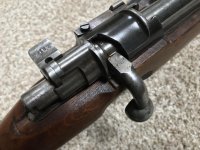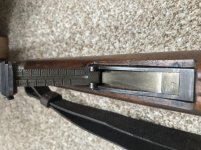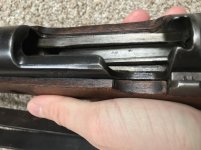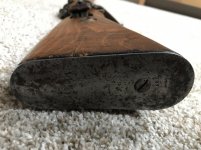Good morning,
I have been searching for an Imperial Gew98 rifle for several years now, and being in Canada, it hasn't been easy. Although this isn't 100% what I was originally after (obviously), given how difficult Imperial stuff in to find up here and what I believe to be a good price I decided to jump on it, at least until something else comes along. At first look, it appears to be a matching 1917 Erfurt Kar98a.
I have done a quick strip of the bolt and it has the last two digits of the serial number on every piece I can find with a number. The stock has the serial number stamped on the underside of the stock and the stacking hook, front sight, screws, bolt assembly (handle/firing pin/cocking piece/extractor, receiver & floor plate assembly. When I first received the rifle it had lots of hardened grease, gunk and dried mud inside the bolt and chamber area. After a light oil the action is very smooth and the bore is in surprisingly beautiful shape. I have not had the carbine out of the stock yet.
The carbine also came with a sling (Gew98 I've been told?) and a muzzle cover.
The stock was damaged long ago by the looks of it, and is cracked / repaired at the wrist. I guess there is no way to tell when this was done, but it certainly has been like this for a long time based on the colouring of the wood and the repair. I intended to shoot the carbine originally, though now am having second thoughts. Is this a "duffle cut" or just some basic repair that could have been done post war?
A few questions for the experts:
1. Does the rifle appear to be correct and not post-war reworked? I can take more photos of anything specific.
2. Do any of the serial numbers look suspect? Being that this is my first Imperial firearm, I am unsure of smaller nuances in the serial numbers. I know that humped Kar98k, P08s etc... are unfortunately getting more common, which pretty much has me concerned when it comes to German stuff. I have a 1939 G29/40 which is mismatched, and I haven't been fortunate enough to come across a potentially "matching" rifle before so this is new to me.
3. What do the acceptance stamps on the right side of the receiver and stock indicate? Is there any way to determine property / ownership? I guess what I am asking here is does this look like a "proper" WW1 Kar98a?
4. I believe after some reading that the serial number prefix is "F", though the script is hard to make out. Is there a way to determine potential month of production?
Overall I am very happy with this handy little carbine so far, even with the potentially sketchy stock repair.

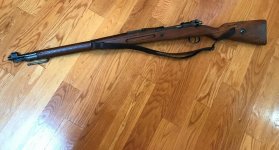
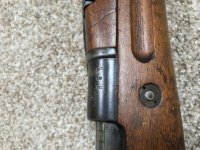


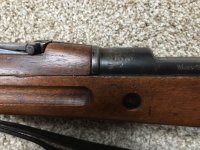


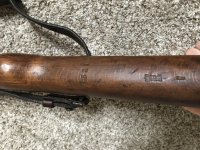


Thanks for all your help! I have been reading here for a long time out of interest but this is my first "jump" into Imperial things.

I have been searching for an Imperial Gew98 rifle for several years now, and being in Canada, it hasn't been easy. Although this isn't 100% what I was originally after (obviously), given how difficult Imperial stuff in to find up here and what I believe to be a good price I decided to jump on it, at least until something else comes along. At first look, it appears to be a matching 1917 Erfurt Kar98a.
I have done a quick strip of the bolt and it has the last two digits of the serial number on every piece I can find with a number. The stock has the serial number stamped on the underside of the stock and the stacking hook, front sight, screws, bolt assembly (handle/firing pin/cocking piece/extractor, receiver & floor plate assembly. When I first received the rifle it had lots of hardened grease, gunk and dried mud inside the bolt and chamber area. After a light oil the action is very smooth and the bore is in surprisingly beautiful shape. I have not had the carbine out of the stock yet.
The carbine also came with a sling (Gew98 I've been told?) and a muzzle cover.
The stock was damaged long ago by the looks of it, and is cracked / repaired at the wrist. I guess there is no way to tell when this was done, but it certainly has been like this for a long time based on the colouring of the wood and the repair. I intended to shoot the carbine originally, though now am having second thoughts. Is this a "duffle cut" or just some basic repair that could have been done post war?
A few questions for the experts:
1. Does the rifle appear to be correct and not post-war reworked? I can take more photos of anything specific.
2. Do any of the serial numbers look suspect? Being that this is my first Imperial firearm, I am unsure of smaller nuances in the serial numbers. I know that humped Kar98k, P08s etc... are unfortunately getting more common, which pretty much has me concerned when it comes to German stuff. I have a 1939 G29/40 which is mismatched, and I haven't been fortunate enough to come across a potentially "matching" rifle before so this is new to me.
3. What do the acceptance stamps on the right side of the receiver and stock indicate? Is there any way to determine property / ownership? I guess what I am asking here is does this look like a "proper" WW1 Kar98a?
4. I believe after some reading that the serial number prefix is "F", though the script is hard to make out. Is there a way to determine potential month of production?
Overall I am very happy with this handy little carbine so far, even with the potentially sketchy stock repair.











Thanks for all your help! I have been reading here for a long time out of interest but this is my first "jump" into Imperial things.

Last edited:





